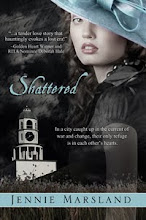
Liam and Alice have found their happily-ever-after …or rather, they’ve found each other and promised to rebuild their lives together. Happiness will take them some time. This is definitely a book that has to have an epilogue, just as Halifax did. The above photo shows reconstruction happening circa 1918, and here's a modern street scene where destruction once reigned.

I’ve found it isn’t easy to write about the devastation of a place you know and love, even if it all happened over ninety years ago. The recent tragedies in Japan and New Zealand haven’t made it easier, but after all, Halifax’s story does have a real happy ending. The human spirit is unstoppable. Now, I have to go back to the beginning and make sure I’ve done my characters justice.
I wish I could step back in time, just for a day, and see the community of Richmond as it used to be. All the accounts I’ve read are full of real affection. I think it was a place where I would have liked to live, an unpretentious neighbourhood where people knew each other’s dogs and cats and kids, with backyards big enough for a milk cow and a few hens. The Hydrostone District that replaced it – named for the cement blocks used for rebuilding after the Explosion – is attractive, with rows of neat garden homes and a strip of fashionable stores and restaurants, including my favourite French bakery.

It’s become a trendy and relatively expensive part of town, but it’s less to my taste than the old neighbourhood would have been. Still, the Hydrostone is a testament to the resilience of Haligonians, and so I appreciate it too.
Now back to work.







